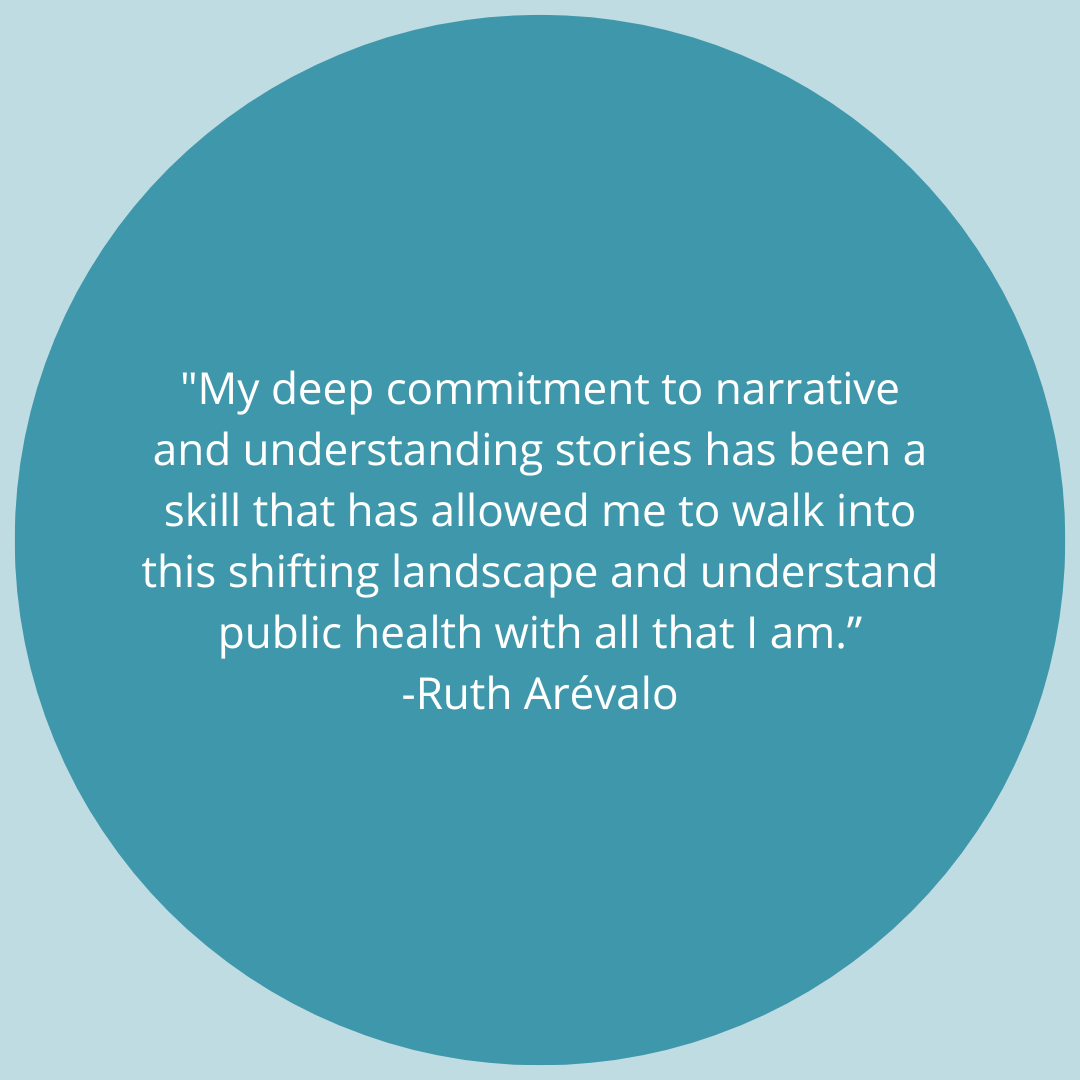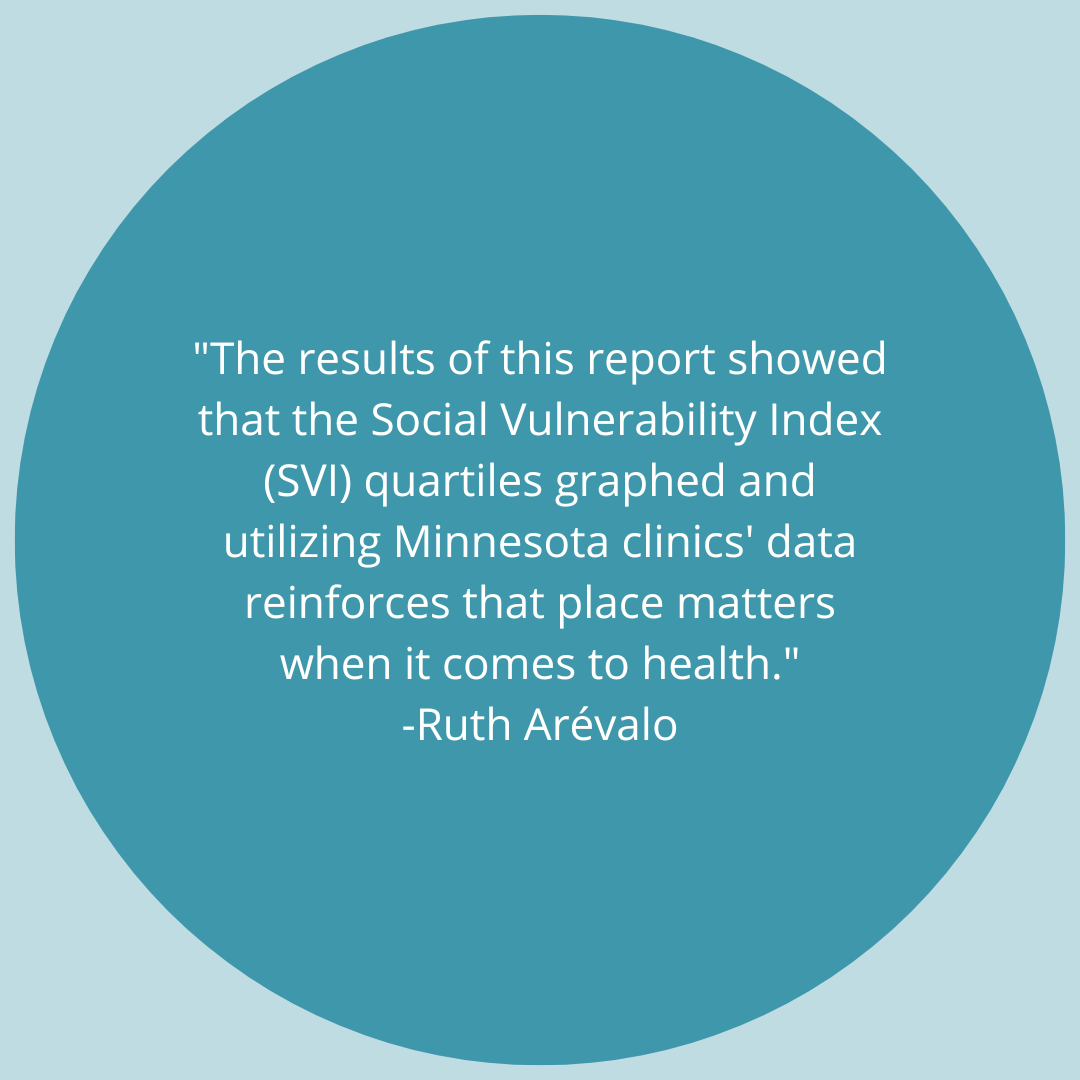#UMNMCH student Ruth Arévalo (they/she) (MPH 2024) wrote this reflection on how their community work, nursing career, and deployment have contributed to their career in Maternal and Child Health.
Path to The UMN MPH MCH Program
Before coming to the UMN MPH MCH program, I worked for 10 years in the fast-paced environment of the culinary industry. Trained in French cuisine with major influences from the Mediterranean. I found the art in mixing flavors, spices, and conversations that brought people together and filled their hearts just as much as their stomachs. I spent my time in restaurants in San Francisco, Mexico, and Utah. The love of food saturated the skills that cultivated vibrance and memories and the love of stories, narratives, and the voices of those closest to me and those strangers who came to sit for a meal.
Though my love of food and the industry remains deep, my relationship with the fast-paced food industry split as it remained incompatible with my other passions and roles in the community. Those that spoke more to gender equity, community, and the slow pace of breaking bread and long conversations on how to create change over kitchen tables and tending to the stories and narratives that were rarely heard.
I come from a long line of family that has been dedicated to community and advocacy. I have spent many years working alongside my community with an intense focus on working alongside immigrant and resettled communities. Through my experience, I also formed a strong passion for working with youth. In conjunction, because of my lived experience, I have sought knowledge and advocacy around identity, reproductive, and sexual health. My intense devotion to being present in the community initiated my slow steps away from the culinary world and I pursued a different education. It took 7 years to complete my schooling to become a registered nurse with hopes of becoming a midwife.
No path is ever straight and I found myself wearing multiple hats as I navigated community and professional lives. As a nurse, I took on roles that continued to speak to looking at health and health access from a critical view. I worked in Oncology, Juvenile Justice Services, as a Sexual Assault Nurse Examiner, and as a teen parent educator. When the COVID pandemic swept through the world, the unknown nature limited the work I was able to do. I was devoted to my work with immunocompromised patients and I knew that my role needed to tend to the ethic of care that I lived by and accountability of entering a global world of unknowns and how we care for our communities. So, I went from
 multiple roles to really focusing on oncology care, health equity, and finding a passion for how narratives shape well-being, especially illness narratives. This focus has led to the devotion of utilizing storytelling as anti-colonial praxis and ways to imagine futurity, especially for marginalized communities and identities. As COVID-19 ruptured how we engage in community and paved isolation into many of our lives, I was not immune to it. The pandemic really shifted how I had to work and live in the world. I had to reimagine myself and where I wanted to go.
multiple roles to really focusing on oncology care, health equity, and finding a passion for how narratives shape well-being, especially illness narratives. This focus has led to the devotion of utilizing storytelling as anti-colonial praxis and ways to imagine futurity, especially for marginalized communities and identities. As COVID-19 ruptured how we engage in community and paved isolation into many of our lives, I was not immune to it. The pandemic really shifted how I had to work and live in the world. I had to reimagine myself and where I wanted to go.
The burnout that the pandemic created seeped deeply into my daily work. I began to rethink why I had gone into nursing. While Midwifery continued to be a dream of mine, jumping back into clinical work felt daunting. With what little energy I had left I found myself intentionally finding a mindset and path to continue learning and cultivating what I had passions about. Though I critique academia immensely, it became a conversation about how to find hope in the chaos unraveling worldwide and to find ways to invest my time in creative ways of change. A return to the focus of navigating my interest in deep thought and reflective/reflexive practice.
The UMN MPH MCH program has allowed intentional time to be dedicated to the ever-pressing questions I have about identity, theories of change, health, health access, health equity, relation to community and land, and how I can cultivate a continued practice of intersectional and anticolonial praxis in my daily life (both personally and professionally). This remains important especially as I learn the path that feels authentic to me to approach reproductive and sexual health within an intersectional MCH focus.
Understanding the Impacts of COVID-19 on Childhood Immunization Acquisition
In 2022 I began my deployment with Hennepin County Public Health (HCPH) as a Community Health Assessment and Project Intern. HCPH is a governmental organization that has a vision to help Hennepin County residents experience optimal health through the different programs that they offer. I completed my deployment with the Immulink and Baby Tracks programs within HCPH. Immulink is a program that partners with Minnesota Immunization Information Connection (MIIC) to track and ensure that Minnesota residents receive immunizations on a timely basis. Baby Tracks is a program in conjunction with Immulink that provides immunizations to children 0-2 to ensure on-time delivery of age-appropriate immunizations.
While working under the guidance of HCPH’s Marie Maslowski, I started my work trying to understand and extrapolate the ongoing conversation of how the COVID-19 Pandemic and vaccine fatigue have impacted the acquisition of childhood immunizations amongst a rise in recent cases (2022) in Minnesota of vaccine-preventable illness. The multifaceted issue brought many things to the conversation but one area that was of desired inquiry of HCPH was to understand how health care provider practice around childhood immunization education with parents-to-be/new parents could affect immunization acquisition. I conducted a condensed literature review of healthcare provider educational practices of childhood immunization, parent perceptions of childhood immunization education, and factors that affected the likelihood that a parent would acquire their child’s immunizations. After analysis and synthesis of the literature, I helped create and format a survey for Hennepin County providers and doulas. I also was able to compile lists of providers and doulas for potential survey participation. My efforts were left as a detailed outline and ready to go through the IRB process.
Social Vulnerability Index Comparison on Childhood Vaccine Acquisition

In conjunction with looking at childhood immunization practice, I also worked with Immulink regional coordinator, Cameron Bright, to author a report and final deliverable that utilized the Social Vulnerability Index (SVI). The data allowed me to share a story of how the SVI can shape how we see and understand childhood immunization acquisition in Minnesota. The SVI index utilizes 16 U.S. census variables to look at the social vulnerability of how external stresses can have potentially negative effects on human health and well-being. The social vulnerability index (SVI) is examined using four themes (socioeconomic status, household characteristics, racial/ethnic minority status, and housing type and transportation). Using the CDC’s Social Vulnerability Index (SVI), Hennepin County Public Health ranked the ZIP code areas of the state and divided them into quartiles. Quartile 1 (Q1) represents the areas of highest disadvantage and quartile 4 (Q4) has the lowest disadvantage. I then ran MICC reports through the Minnesota Department of Health (MDH) on childhood immunization acquisition rates from 6 SVI 1 and 7 SVI 4 clinics. The MIIC childhood assessment report measured the rate at which children aged 24-35 months were up to date on their vaccines (9 recommended vaccines) by 24 months, as defined by the Advisory Committee on Immunization Practices (ACIP). I pulled data from each of the clinics and graphed rates across immunization types and then across SVI quartiles. The results of this report showed the SVI quartiles graphed and utilized Minnesota clinics’ data that reinforces that place matters when it comes to health. Minnesota SVI 1 clinics had lower acquisition rates across the board.
How We Find “Story” in All That We Do. We Walk as We Question.
My time with HCPH has added to the non-linearity of my story of self. My deep commitment to narrative and understanding stories has been a skill that has allowed me to walk into this shifting landscape and understand public health with all that I am. Working with HCPH brought all new environments and relationships that I had never been in before. Because of my community organizing, nursing background, MCH coursework, and this deployment, I have been able to listen attentively and ask questions along the way to further the dynamic relationship of change within HCPH and the outlook of further public health issues. It remains imperative to be intentional about the stories we create and how we use questions, data, and information to tell stories of our complex world.
SOURCES/REFERENCES
About MIIC – Minnesota Dept. of Health. (n.d.). Www.health.state.mn.us.
https://www.health.state.mn.us/people/immunize/miic/about.html
ATSDR. (2020, October 15). CDC’s Social Vulnerability Index (SVI). Www.atsdr.cdc.gov.
https://www.atsdr.cdc.gov/placeandhealth/svi/index.html
Baby tracks. (n.d.). Hennepin County, Minnesota. https://www.hennepin.us/residents/health-medical/baby-tracks
CDC. (2023, February 10). Birth-18 years immunization schedule. Centers for Disease
Control and Prevention; CDC.
https://www.cdc.gov/vaccines/schedules/hcp/imz/child-adolescent.html
Health officials confirm two cases of measles in Hennepin County siblings – MN Dept. of Health. (n.d.). https://www.health.state.mn.us/news/pressrel/2022/measles061422.html
ImmuLink. (n.d.). Hennepin County, Minnesota. https://www.hennepin.us/residents/health-medical/immulink
Place matters: The environment we create shapes the foundations of healthy development – Center on the Developing Child at Harvard University. (2023, April 24). Center on the Developing Child at Harvard University. https://developingchild.harvard.edu/place-matters-the-environment-we-create-shapes-the-foundations-of-healthy-development/
Su, Z., Cheshmehzangi, A., Cheshmehzangi, A., McDonnell, D., Da Veiga, C. P., & Xiang, Y. (2022). Mind the “Vaccine fatigue.” Frontiers in Immunology, 13. https://doi.org/10.3389/fimmu.2022.839433
BIO
Ruthie is a third-year MCH MPH student with a minor in sexual health. Their background is in culinary arts and nursing. Ruthie received their AS from the California Culinary Academy then their BS in Health, Society, and Policy, and subsequently another BS in Nursing from the University of Utah. They recently moved across the country to Lawrence, Massachusetts, and have started working at Lowell Community Health Center in the OB/GYN clinic as they finish out their final year of their MCH program. In their spare time, they enjoy writing, cooking, reading, running, and being in community. After graduating, Ruthie hopes to continue to find ways to integrate public health into community engagement that focuses on community well-being as well as integrate narrative and storytelling into how change is created and remembered. A duty to remember and to follow in the footsteps of those who came before them.
–Read Student Spotlight archives
Interested in learning more about getting a degree in MCH? Visit our MCH Program page for more information.
#UMNMCH #UMNproud #UMNdriven